Ashgabat – The Golden Age
“It is not real gold. Every year, in January, workers have to replenish the color. Is that real gold, then?”
-Jeyhun, A student from Turkmenabat
At this hazy day with some degrees of rain, the Ashgabat train station was full of people queuing for tickets. It was messy. There were 8 counters, all with a horde of people trying to be the first in front of the small window, where behind the glass, a Turkmen lady – the ticket seller, shouting harshly to the people. It was typical of ex-Soviet service. The ticket sellers are the kings. The buyers should be nice to be served.
There were lockets for same-day departures, and pre-booking. I was queuing in front of a locket just to be told I should go to another counter for pre-booking. Another 30 minutes were wasted. The ticket lady said that all tickets for Turkmenabat for day-after-tomorrow departure were already sold out. Not gave up, I went to another counter for last try. I was worrying though, as the closer it was to Navruz – the Persian and Central Asian New Year – transports were hard to come by. The third ticket lady told me that tickets were still available only if I didn’t mind with normal wagon. I had no idea what normal wagon meant, but I bet it should be similar to Indonesian ‘kelas ekonomi’. I was surprised when she told me the price, 15,000 Manat. On besh ming Manat. How much? Yes, 15,000 Manat. It was about 60 cents US$, less than 6,000 Rupiah, for that 600 km distance to be covered in never-ending 16 hour of journey. It might be part of the Golden Age architecture planned by the Great Leader: all public services and basic food are provided free for citizens. You might be surprised also to know that the cost of flight ticket from Ashgabat to Turkmenistan was merely as low as 1.50 US$.
The rain got heavier. I went to post office to buy some stamps for my collection. On the way, a man in his late 20’s but looked much older stopped me and chatted. Then he followed me all the way while kept talking how life was bad here. “Turkmenistan is bad for work. Here we don’t have money.” His name was Marat, worked as car washer. But today with His rain, God provide all car owners free car washing. Marat didn’t have anything to do, but spending time with strangers like this. His income was 30,000 to 40,000 Manat for each time he cleaned a car. It was not too bad actually. But there were not too many cars to wash in this small capital of Ashgabat anyway. “Uzbeks are cleverer than us. They really use their brain,” said him praising the always-busy neighboring country.
We went to main post office of Ashgabat. It was a small office with counters only selling magazines (all with pictures of the great Turkmen leader), greeting cards, envelopes, parcel box, etc. Most of the counters were idle. There were only two different stamps they sold here, and all were stickers. The concept of ‘stamp collecting’ ironically seemed so foreign in this country’s main post office.
I went to nearby Internet Café to check the address of the philatelic item seller in Ashgabat. Internet was very limited here. The price of 1 hour access was 90,000 Manat (almost 4 US$). First, one had to register his name at the counter, then paid the amount he wanted to use to the officer, and the lady-in-charge would start her stopwatch. The costly Internet, compared to next-to-free transport rides, showed that Internet was something undesirable by the Great Leader. It was no scene of Uzbek boys busy playing Counter Strike in Game Centers like in Bukhara. Computer games and Internet Cafés was not part of this country life. Students should spend their time only for studying and developing nationalism, or other useful things. For sure time should not be wasted for Counter Strike or poisonous Internet.
Ashgabat, literally means ‘City of Love’, but it was a big man figure rather than love that people felt more here. I noticed more presence of the Great Saparmyrat Turkmenbashi Niyazov after short walk around the city. All ministries and government offices had at least one huge statue of him (mostly gold polished) in front of each. The Great Leader was pictured in different poses: sitting, waving right hand, waving both hands, standing, facing the sun, reading book, etc. Every statue had at least one soldier to guard it. The soldiers strolled around those glittering statues as they were to guard national treasures. Slogans were everywhere. Being a visitor, you would be indoctrinated about Ruhnama (Book of Soul), the Golden Age (Altyn Asyry), the Independence and Always Neutral Turkmenistan (garassyz we hamishelik bitaraplik Turkmenistan), and after all, the figure of the Great Leader whom you can see from all directions standing towards the sun at the top of a huge arch. Even an Indonesian friend who once visited Ashgabat told me when she stayed in five-star hotel, the ceiling of the hotel room was decorated with photos of President. When she opened her eyes to greet the morning, the first thing she had to see was the Saparmyrat’s morning smile.
I collected my pieces of past from Ashgabat face. Ruhnama was Pancasila. The golden age was what so-called era tinggal landas, masyarakat adil makmur, or Indonesia emas. The neutrality was non blok, ekonomi kekeluargaan, politik bebas aktif, demokrasi, era keterbukaan, and many other jargons of our previous regime’s order. The man behind of all of these was our great leader, our hero of development, Mr. Suharto.
Places were sensitive here. Even walking near the President Palace would already attract the attention of the soldiers. I passed through those golden-domed palaces, the Turkmenbashi Palace. Two soldiers came and asked, “Why you took photos?” They were Maksat and Rahim, both 18 years old, serving their 2-year-compulsory military service. I was in big problem, but I pretended to know nothing. Then they asked why I was so small. Turkmens were, in average, the tallest people I have ever seen. It was not because I was short, but it was indeed difficult to find any men shorter than me in this country, somehow. I said, “I didn’t eat as much as you do when I was younger.” They laughed. Maksat then explained to me quite friendly, “You can take photos of all buildings, but not his golden domed palace. This is a secret.”
Rahim asked for souvenirs then. I gave him some Rupiah banknotes which pleased both of them. The two soldiers who were supposed to arrest me of taking photos of ‘national secret’ turned to pose in front of my camera with the giant monument as background.
Before coming to Turkmenistan, I often read foreign media comparing the country with North Korea. It was not completely exact comparison though. In North Korea foreigners were not allowed to talk at all with locals, even if it was for exchanging greetings. In Turkmenistan, people were quite friendly and open to share about their life in the country. Somehow Ashgabat city dwellers were much friendlier compared to others in Central Asian capitals. Batyr, a traffic police, whose work was not only to control the traffic but also to give salutation to all cars with diplomatic or government plate number passing through, even offered me to stay with him as he was staying alone in his own room.
South of the monument there was huge park with statue of ten horses to mark the 10th anniversary of the independence of the country. The park was well-known as ’10 horses’. There was also a lovely golden statue of the leader which became favorite photo place for wedding couples. I saw a couple making wedding photos here. There were many women dancing and many of them were wearing Turkmen traditional dresses, which reminded me to those of desert tribes in Thar Desert (Pakistan, India). There was also a group of musician to fill the atmosphere, with their complete weapon sets, from flutes to accordions. The bride wore beautiful, sophisticated dress as well, but her face was fully covered by veil. In Ferghana Valley of Uzbekistan, I saw a bride’s veil was transparent. This Turkmen bride wore solid, thick garment for her veil. It was the burqa as what was used in old Bukhara times.
It was the Russians who lifted the veil off women faces in Central Asia. Despite of this, it was not a complete sign of freedom. People in Soviet times were supposed not to talk with strangers, as spy agents might suspect them of subversive plots. People were not allowed to gather without permission, should not talk, should not discuss. Some Turkmen men, as what they believed, told me that it was Turkmenbashi who brought back their freedom.
With only 3000 Manat one could ascend to the top of ‘Arch of Turkmenistan Neutrality’ tower, which topped by gold-polished statue of Turkmenbashi, rotating around 360 degree following the sun. It was kind of Monumen Nasional we have in Jakarta, a memorabilia of lighthouse policy of our first president: a phallic monument topped by a 40 kg golden flame (40 kg of gold was sign of wealth that Indonesia had to show to the world). As in Monumen Nasional, from the top of Turkmenistan Neutrality Arch one might spot the best city view panorama of Ashgabat. Parks were everywhere, as well as white marble buildings radiating to all directions. Meanwhile, old people housing, those old and ugly contrast to what was new and modern, mixed together to make contrasting strips. I just imagined whether Turkmenbashi once stood here and from here he decided: OK, this old complex should be demolished and we build a Disneyland here, and that ugly houses should be flattened and we build my statues there…..
Every Saturday and Sunday, a small park near the 10 Horse statue was home to local concerts. I was told by someone. But when I came in I was stopped by the policemen. Showing their authority they didn’t let me in and threaten to bring me to jail. Fulfilling their needs of power, I insisted but kept my jovial manner, before then slipped into the crowds. Here I noticed, everybody wore the same clothing. It was only me being different. No wonder why the policemen didn’t let me in.
All of the young boys in the park were wearing white shirt, tie, black pants, and beautiful black suits. All the heads was covered by colorful traditional caps (tahia). It was a mixture of western and Turkmen values. The girls also wear the caps as well as traditional dresses. The concert had some programs, but mostly traditional songs. At the end of the show, there were a group of Turkmen male dancers with their huge, white, shaggy sheepskin hats (telpek), of which appearance might remind Indonesians to the old Ahmad Albar with his grey hair. There were a group of women with flowers. The traditional dance was energetic, but the lyric of the music was more interesting. I caught some words: Ruhnama, Turkmenistan, Buyuk Turkmenbashi. They were dancing with broad smiles, energetic movement, in front of posters of Saparmyrat Niyazov and books of Ruhnama. If I may translate to our own Indonesian version, this might be on par Achehnese Saman dance, energetic dance of pairs of Muslim boys and girls, with music praising Pancasila, Development, and our Father of New Order.
The local TV cameramen and photographers took documentation of the performing students. I thought those photos would decorate the magazines sold in kiosks. Almost all magazines I saw in the magazine kiosks were about the government programs and success.
This concert was only interesting to these university students. They were not actually interested though. Being present here is compulsory. Every occasion had students of different university to perform and to be spectacles. They needed a bunch of students before the stage to be recorded in the movie for TV broadcast. The crowd of these spectacles disappeared immediately right after the dances finished. The camera didn’t shoot them anymore. And their duty to watch the show also finished.
I walked home with a student of that university who was studying mechanical engineering. He was from Turkmenabat and he said that his family was originated from Karakul. This is not Karakul of Tajikistan, Kyrgyzstan, or China. ‘Karakul’ was somehow so trendy that many places in Central Asia bear the same name. This is Karakul of Uzbekistan, a small town near the Turkmen border, south of Bukhara. Jeyhun, this boy’s name – which means Amu Darya (Oxus River) in Turkmen language, explained to me about the rule and order in Turkmenistan. “We have to ear this costume,” said him while pointing his western suit, “no matter we like it or not.” The western suit, as in Tajikistan, was student’s uniform. I pointed how it was expensive. “No matter. This is good. Students here are good looking. And nothing wrong to look good,” replied him.
Turkmenistan was wealthy country, and as he said, nothing wrong to look good. So was the traditional cap. That was also part of their uniform, which they have to wear it anyhow, no matter they like it or not. Later on I learnt from Turkmenbashi writing of Ruhnama, that to look good was one of the most important Turkmen values, as Prophet Noah said (as cited by Turkmenbashi): “Good clothes improve the external appearance and make people look good. Choose clothes that suit you.” Combination between western suit and Turkmen tahia might be what he meant as the clothing suit the Turkmens.
“Universities in Turkmenistan are free. Not only free, we got money from government, 1 million Manat per month.”
It was a big amount of money, about 40$ per month for every university student. No wonder that these students could afford high quality suits ‘to improve their external appearance and to make them look good’. I was told that a suit like this cost anywhere between 40$ to 100$ each, and they needed at least two of it to survive the university days.
While they had such improved external appearance and was made look good, Jeyhun showed his unawareness of a country named ‘Indonesia’, its big Muslim population, nor big earthquake and tsunami. I was surprised about the last item, as everybody in Turkmenistan knew exactly about the tragedy of their nation, when Ashgabat was flattened by big earthquake in the beginning of XX century. But Jeyhun knowledge was limited to only Turkmenistan and its past.
We passed through the park with golden statue of the leader on the top of high monument. I said to him that I appreciated very much the golden age that the leader promised the citizens.
He was surprised.
“You think that is real gold?” questioned him pointing to the golden statue with his eye stares, “It is not real gold. Every year, in January, workers have to replenish the color. Is that real gold, then?”

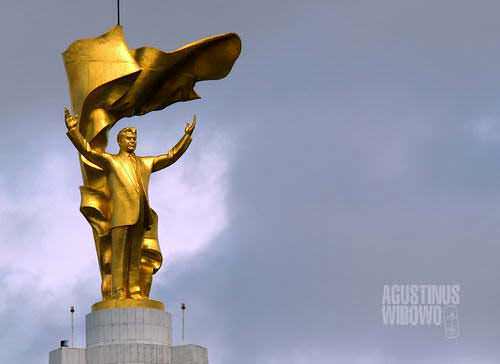

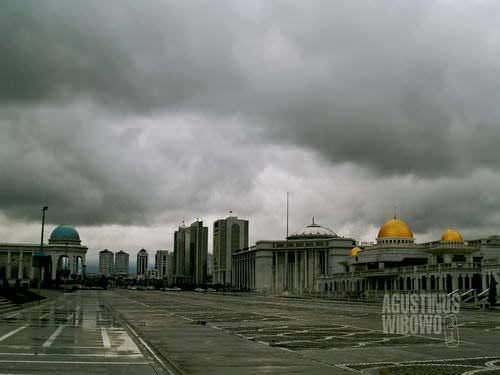
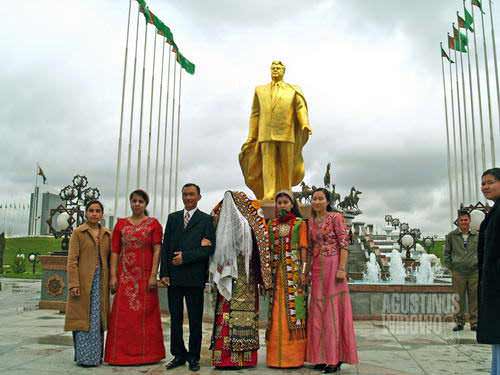

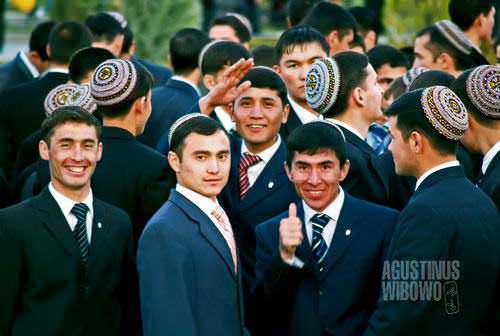
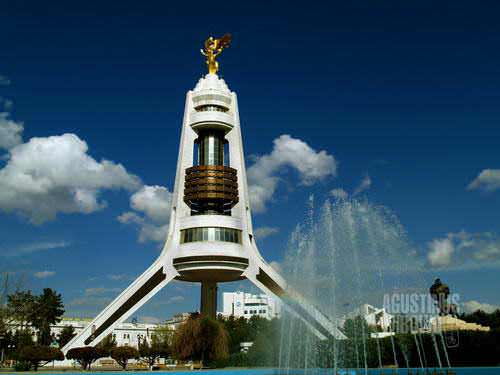





Ashgabat, literally means ‘City of Love’ what a beautiful name.